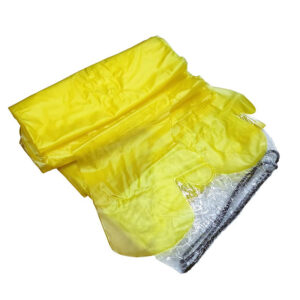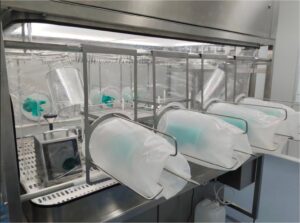In the ever-evolving landscape of pharmaceutical and biotechnology industries, maintaining the highest standards of safety and sterility is paramount. One crucial aspect of this safety protocol is the integrity of gloves used in isolators and restricted access barrier systems (RABS). Glove integrity testing systems have emerged as essential tools to ensure the safety and efficacy of these critical environments.
As the demand for aseptic processing and contamination control continues to grow, the importance of reliable glove integrity testing cannot be overstated. These systems play a vital role in preventing breaches that could compromise the sterility of isolators and potentially jeopardize product quality or patient safety. By employing advanced technologies and methodologies, glove integrity testing systems provide a robust defense against contamination risks.
The evolution of glove integrity testing systems has been driven by the need for more accurate, efficient, and automated solutions. From visual inspections to sophisticated pressure decay tests, the field has seen significant advancements. This article will delve into the various aspects of glove integrity testing systems, exploring their functionalities, benefits, and the critical role they play in ensuring isolator safety.
Glove integrity testing systems are indispensable tools in maintaining the sterility of isolators and RABS, providing a crucial line of defense against contamination risks in pharmaceutical and biotechnology environments.
What are the key components of glove integrity testing systems?
At the heart of every glove integrity testing system lies a set of essential components that work in harmony to ensure accurate and reliable results. These systems typically consist of a control unit, pressure sensors, pneumatic connections, and software for data analysis and reporting.
The control unit serves as the brain of the system, coordinating the testing process and managing the flow of information. Pressure sensors play a crucial role in detecting even the slightest changes in pressure within the glove, allowing for the identification of potential breaches. Pneumatic connections facilitate the controlled inflation and deflation of gloves during testing, while sophisticated software analyzes the data and generates comprehensive reports.
One of the most critical components of modern glove integrity testing systems is the pressure decay test module. This module utilizes the principle of pressure decay to detect leaks or punctures in gloves, offering a high degree of sensitivity and reliability.
Advanced glove integrity testing systems incorporate state-of-the-art pressure decay test modules, capable of detecting leaks as small as 10 microns in diameter, ensuring the highest level of safety in isolator environments.
| Component | Function |
|---|---|
| Control Unit | Manages testing process and data flow |
| Pressure Sensors | Detect pressure changes within gloves |
| Pneumatic Connections | Facilitate glove inflation and deflation |
| Software | Analyzes data and generates reports |
| Pressure Decay Module | Detects leaks using pressure decay principle |
How do pressure decay tests enhance glove integrity testing?
Pressure decay tests have revolutionized the field of glove integrity testing, offering a level of accuracy and reliability that surpasses traditional methods. This testing approach involves inflating the glove with a predetermined pressure and then monitoring the pressure over a set period. Any decrease in pressure beyond the acceptable threshold indicates a potential leak or breach in the glove's integrity.
The pressure decay method offers several advantages over other testing techniques. It provides quantifiable results, allowing for precise measurements and trend analysis. Additionally, this method is non-destructive, meaning gloves can be tested repeatedly without compromising their integrity.
One of the key benefits of pressure decay tests is their ability to detect even microscopic leaks that might be missed by visual inspections or water-based tests. This heightened sensitivity is crucial in maintaining the sterility of isolators and preventing contamination risks.
Pressure decay tests can detect leaks as small as 5 microns in diameter, providing a level of sensitivity that is unmatched by traditional glove integrity testing methods.
| Pressure Decay Test Feature | Benefit |
|---|---|
| Non-destructive | Allows for repeated testing |
| High sensitivity | Detects microscopic leaks |
| Quantifiable results | Enables precise measurements and trend analysis |
| Automation-friendly | Facilitates integration into production lines |
What role does automation play in modern glove integrity testing systems?
Automation has become a cornerstone of modern glove integrity testing systems, offering numerous benefits in terms of efficiency, accuracy, and consistency. Automated systems can perform tests on multiple gloves simultaneously, significantly reducing the time required for comprehensive testing of isolator environments.
The integration of automation in glove integrity testing systems has led to the development of sophisticated, user-friendly interfaces that guide operators through the testing process. These interfaces often include touchscreen displays, intuitive controls, and real-time data visualization, making the testing process more accessible and less prone to human error.
Furthermore, automated systems excel in data management and reporting. They can generate detailed reports, store historical data, and even integrate with facility-wide quality management systems. This level of data integration and traceability is invaluable for regulatory compliance and continuous improvement initiatives.
Advanced automated glove integrity testing systems can test up to 20 gloves simultaneously, reducing testing time by up to 80% compared to manual methods while maintaining the highest standards of accuracy and reliability.
| Automation Feature | Impact |
|---|---|
| Simultaneous multi-glove testing | Increased efficiency |
| User-friendly interfaces | Reduced operator errors |
| Integrated data management | Enhanced traceability and compliance |
| Real-time monitoring | Immediate detection of anomalies |
How do glove integrity testing systems ensure regulatory compliance?
In the highly regulated pharmaceutical and biotechnology industries, compliance with stringent standards is non-negotiable. Glove integrity testing systems play a crucial role in ensuring that isolators and RABS meet the regulatory requirements set forth by agencies such as the FDA and EMA.
These systems are designed to comply with international standards such as ISO 14644-7, which outlines the requirements for separative devices in cleanrooms and associated controlled environments. By adhering to these standards, glove integrity testing systems help facilities maintain their clean room classifications and ensure the sterility of their processes.
Moreover, modern glove integrity testing systems offer robust documentation and reporting capabilities. They can generate detailed test reports, maintain audit trails, and provide data in formats that are easily accessible for regulatory inspections. This level of transparency and traceability is essential for demonstrating compliance during audits and inspections.
Leading glove integrity testing systems are designed to meet or exceed ISO 14644-7 standards, providing pharmaceutical and biotechnology companies with the assurance of regulatory compliance and the highest levels of sterility control.
| Regulatory Aspect | System Feature |
|---|---|
| ISO 14644-7 Compliance | Adherence to international standards |
| FDA 21 CFR Part 11 | Electronic records and signatures |
| EU GMP Annex 1 | Sterility assurance for aseptic processing |
| Data Integrity | Secure, traceable data management |
What are the latest innovations in glove integrity testing technology?
The field of glove integrity testing is continually evolving, with new technologies and methodologies emerging to address the growing demands of the industry. One of the most significant innovations in recent years has been the development of wireless glove leak testers. These systems eliminate the need for physical connections between the testing unit and the gloves, offering greater flexibility and reducing the risk of damage to the isolator or RABS.
Another cutting-edge development is the integration of artificial intelligence and machine learning algorithms into glove integrity testing systems. These advanced technologies can analyze vast amounts of data to identify patterns, predict potential failures, and optimize testing protocols. By leveraging AI, facilities can move from reactive to proactive maintenance strategies, potentially preventing glove failures before they occur.
YOUTH has been at the forefront of these innovations, continuously developing and refining glove integrity testing systems to meet the evolving needs of the industry. Their commitment to excellence and innovation has made them a trusted partner for pharmaceutical and biotechnology companies worldwide.
Next-generation glove integrity testing systems incorporating AI and machine learning can predict potential glove failures with up to 95% accuracy, allowing for proactive maintenance and significantly reducing the risk of contamination events.
| Innovation | Benefit |
|---|---|
| Wireless Testing | Increased flexibility and reduced risk of damage |
| AI Integration | Predictive maintenance and optimized testing |
| IoT Connectivity | Real-time monitoring and remote diagnostics |
| Virtual Reality Training | Enhanced operator training and reduced errors |
How do glove integrity testing systems contribute to overall facility safety?
Glove integrity testing systems are not just isolated tools; they are integral components of a comprehensive safety strategy in pharmaceutical and biotechnology facilities. By ensuring the integrity of gloves in isolators and RABS, these systems play a crucial role in maintaining the sterility of critical environments and protecting both products and personnel.
The regular use of glove integrity testing systems helps create a culture of safety and quality within facilities. It encourages operators to be more mindful of glove handling and usage, potentially reducing the likelihood of accidental breaches. Furthermore, the data generated by these systems can be used to identify trends, optimize glove replacement schedules, and inform training programs.
In the event of a contamination incident, glove integrity testing systems provide valuable data for root cause analysis. The detailed records of glove performance and testing history can help investigators pinpoint the source of the contamination and implement corrective actions to prevent future occurrences.
Facilities that implement comprehensive glove integrity testing programs have reported a 40% reduction in contamination incidents related to glove failures, demonstrating the significant impact these systems can have on overall safety and product quality.
| Safety Aspect | System Contribution |
|---|---|
| Contamination Prevention | Regular integrity checks |
| Personnel Protection | Early detection of potential exposures |
| Product Quality Assurance | Maintenance of sterile environments |
| Incident Investigation | Detailed historical data for analysis |
What factors should be considered when selecting a glove integrity testing system?
Choosing the right glove integrity testing system is a critical decision that can have far-reaching implications for facility safety and operational efficiency. When evaluating different systems, several key factors should be taken into account to ensure the best fit for your specific needs.
First and foremost, the system's accuracy and sensitivity should be thoroughly assessed. The ability to detect even the smallest leaks is crucial for maintaining the highest standards of sterility. Additionally, the system's capacity and throughput should align with your facility's testing requirements to avoid bottlenecks in the production process.
Ease of use and integration with existing systems are also important considerations. A user-friendly interface and intuitive controls can significantly reduce the learning curve for operators and minimize the risk of human error. Furthermore, the system's compatibility with your facility's data management and quality control systems can streamline reporting and enhance overall efficiency.
Lastly, consider the long-term support and service offered by the manufacturer. Regular maintenance, calibration, and software updates are essential for ensuring the continued reliability and performance of the system. A manufacturer with a strong track record of customer support and ongoing innovation can be a valuable partner in maintaining the safety and compliance of your facility.
When selecting a glove integrity testing system, prioritize systems that offer a combination of high accuracy (detecting leaks as small as 5 microns), user-friendly interfaces, and robust data management capabilities to ensure long-term value and reliability.
| Selection Factor | Importance |
|---|---|
| Accuracy and Sensitivity | Critical for detecting small leaks |
| Capacity and Throughput | Ensures efficient testing processes |
| Ease of Use | Reduces operator errors and training time |
| System Integration | Enhances data management and reporting |
| Manufacturer Support | Ensures long-term reliability and performance |
In conclusion, glove integrity testing systems are indispensable tools in the arsenal of pharmaceutical and biotechnology facilities striving to maintain the highest standards of safety and sterility. These sophisticated systems, with their advanced pressure decay testing capabilities and automated features, provide a robust defense against contamination risks in critical isolator environments.
As the industry continues to evolve, so too will the technologies behind glove integrity testing. The integration of artificial intelligence, wireless testing capabilities, and enhanced data analytics promises to further refine these systems, offering even greater levels of safety, efficiency, and regulatory compliance.
For facilities looking to implement or upgrade their glove integrity testing protocols, Glove integrity testing systems represent a critical investment in quality assurance and risk mitigation. By carefully selecting and implementing these systems, companies can ensure the integrity of their isolators, protect their products, and ultimately safeguard the health of patients worldwide.
The future of pharmaceutical and biotechnology manufacturing will undoubtedly bring new challenges and opportunities. However, with continued innovation in glove integrity testing systems and a commitment to best practices, the industry is well-equipped to meet these challenges head-on, ensuring the highest levels of safety and quality in the years to come.
External Resources
GITS Glove Integrity Testing System – Comecer – This system tests glove integrity using the pressure decay method in conformity with ISO 14644-7, Annex E.5. It is designed for safety, ease of use, and flexibility, and can test up to 20 gloves simultaneously.
Glove testing systems: ensuring the highest levels of safety – Cleanroom Technology – This article discusses various methods of glove testing, including visual inspection, water tests, and the pressure decay test. It emphasizes the importance of the pressure decay test for its high reproducibility and accuracy.
Glove Testing Systems – The highest safety for isolators and RABS – Syntegon – Syntegon's glove testing systems use the pressure decay method, ensuring high reproducibility and accuracy. The system stretches gloves before testing and can be integrated into production lines.
Wireless Glove Leak Tester (GLT) for isolators – Getinge – Getinge's GLT uses the pressure decay method to test glove integrity. It is wireless, paperless, and pipeless, ensuring full connectivity and traceability, and is compliant with FDA and GMP guidelines.
The weakest link? Assessing isolator glove integrity failures – EJPPS – This article discusses the importance of glove integrity testing, highlighting the pressure hold and pressure decay methods. It emphasizes the need for specialist integrity testing equipment to ensure contamination control.
Glove Integrity Testing: Ensuring Safety in Isolators and RABS – Pharmaceutical Technology – This resource provides an overview of glove integrity testing methods, focusing on the pressure decay test and its advantages in ensuring safety and compliance in pharmaceutical environments.
Isolator Glove Testing: Best Practices and Regulatory Compliance – ISPE – This article from ISPE discusses best practices for isolator glove testing, including the importance of regular testing, proper test methods, and compliance with regulatory standards.
Glove Integrity Testing for Aseptic Processing – PDA – This technical report from PDA focuses on glove integrity testing as part of aseptic processing, detailing the various test methods and emphasizing the critical role of gloves in maintaining a sterile environment.
Related Contents:
- Compact Sterility Test Isolators for Small Labs
- Glove Sterility Test Isolators: Essential Guide 2025
- Custom Sterility Test Isolators: Top 5 Designs 2025
- PLC Control Systems for Sterility Test Isolators
- Half-Suit Sterility Test Isolators: Ergonomic Design
- Flexible Wall Isolators: Cost-Effective Sterility Testing
- HEPA Filtration in Sterility Test Isolators: Key Facts
- Modular Sterility Testing Isolators: Flexible Solutions
- Multi-Chamber Sterility Test Isolators: Versatile Testing




























